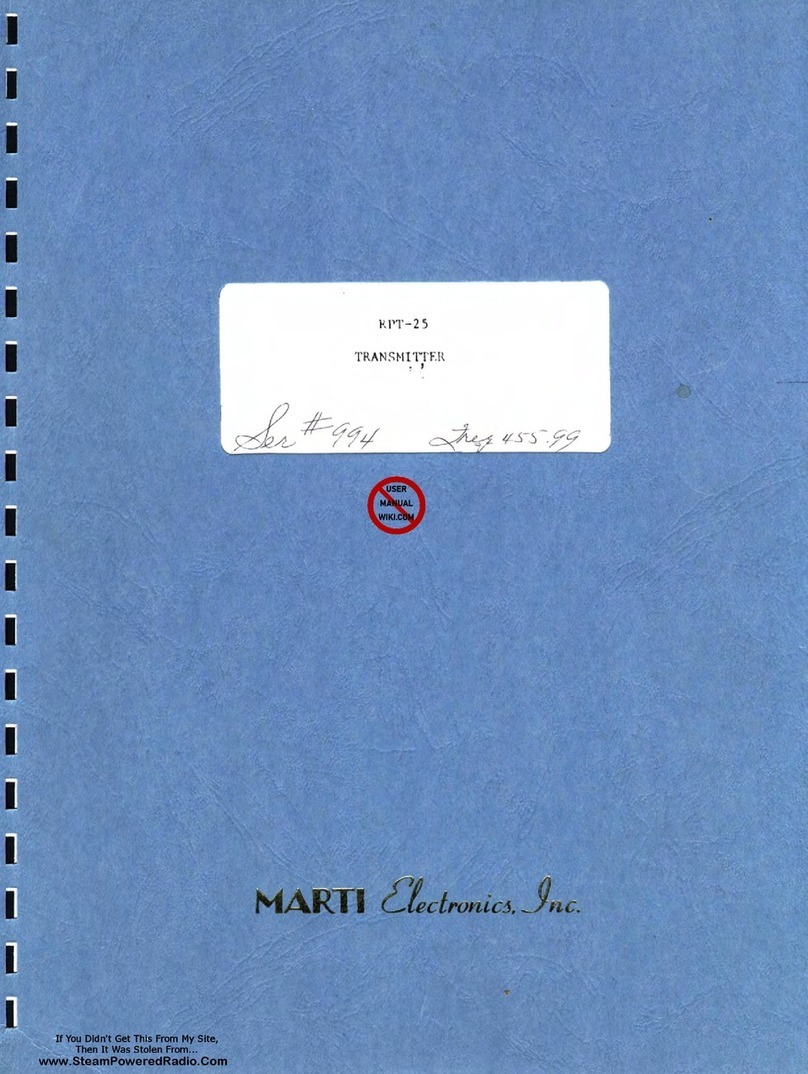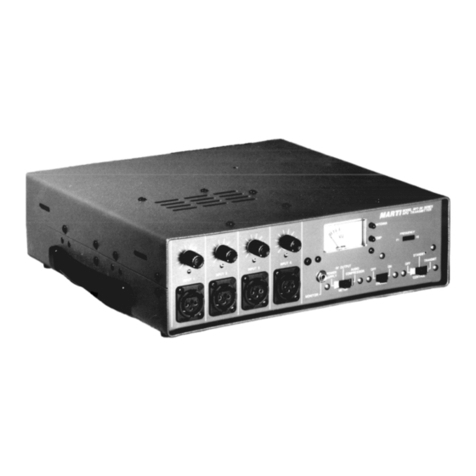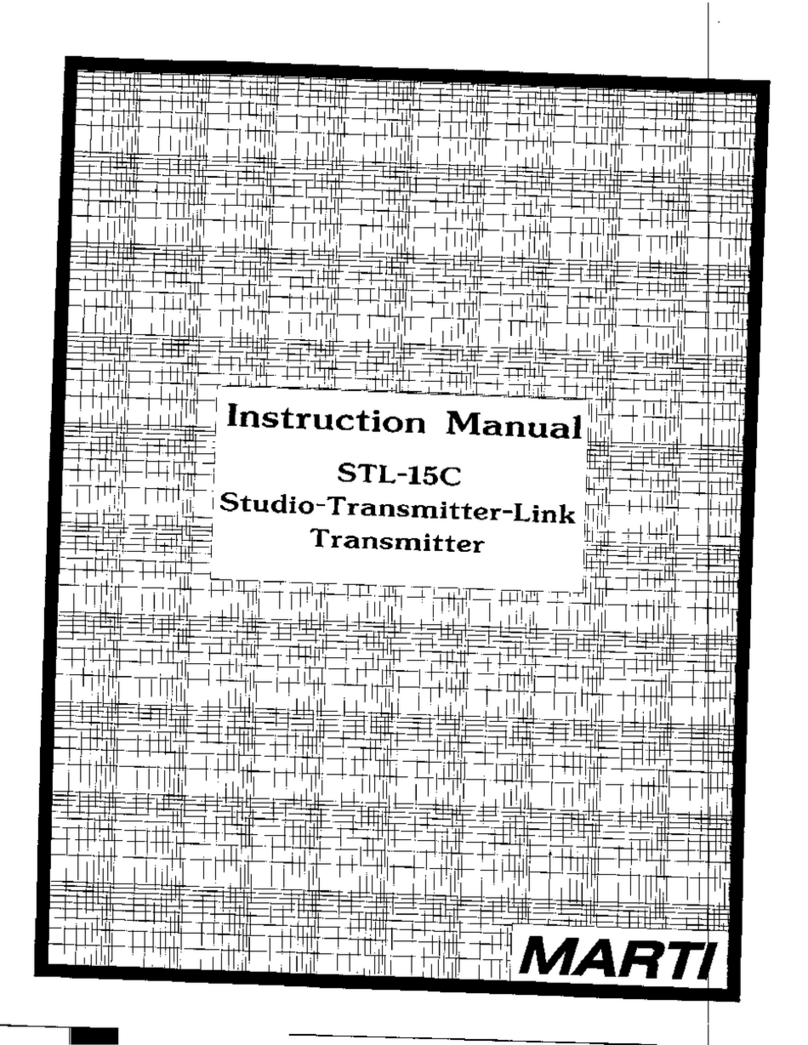
www.SteamPoweredRadio.Com
!ANTENNAS
The
followingsuggestions are o
ff
ered to
he
lp those
responsible for antenna installations avoid costly
er
rorsin assembly and adjustment. Marti Electronics,
Inc. assumes no responsibility
for
the installation and
performance
of
antenna systems associated with
its
equipment. The following suggestions are notintended
to be a complete step-by-step procedure, simply a
listing
of
so
me of the m
ost
frequ
en
tly reported errors
in antenna system installation.
Antenna Assembly
Fo
ll
ow
the manufacturer's instructions carefully. If
no instructions were included with the ant
en
na,
ca
ll or
write the antenna manufacturer for instructions. Errors
are frequently made in assembly
of
the
RF
feed dipole
elements which must be installed in
th
e same plan as the
reflector grids. ln other words,
if
the reflector grid
elements are horizontal, then the feed dipole elements
must also
be
horizontal. Cross polarization
of
grid and
feed dipole will result in total loss
of
antenna gain
!.
Transmission Line Connector Assembly
Do not u
se
RG-58 U
or
RG-8 U cable for
STL
station
antennas! They have t
oo
much loss at
VHF
and UHF
frequencies. Follow the instructions furnished by the
manufactur
er
wh
en
cutting coaxial
cab
le. Inspect the
ca
ble ends for small metal fragments which can short-
circuit the line inside the connector assembly. Che
ck
the
line for a sh
or
t-c
ir
cuit
co
ndition after each connector is
install
ed
by using an ohmmeter. Pressurized line should
be checked for several days under pressu
re
before instal-
lation on a tower to ensure that
th
ere
are
no leaks in the
line or fittings
Moisture Proofing Coax Connectors and
Fittings
Ex
tr
eme care must be
exe
rcised with coaxial cable
before and after
co
nn
ec
tors have been installed to ensure
th
at
moisture does n
ot
e
nt
er the line. Foam dielectric line
can
ta
ke on moisture ab
so
rption which is difficult
to
detect and remedy.
Th
erefor
e,
k
eep
the line
dry
while in
storage with ends tightly capped. Coaxial splices,
co
nnec-
tors, and fittings, to be located outside should
be
made
mechanically tight, then
coa
t
ed
with a weather-proofing
material over at l
eas
t two layers
of
vi
nyl plastic electrical
tape. Moisture problems in antenna systems are usually
traced back
to
connectors which have
NOT
been properly
taped.
Th
e Marti
K-1
Grounding and W
ea
therproofing Kit
is recommended for u
se
in each new antenna in
stal
lation.
7
Location and Grounding of
Coa
xial Ca-
ble
Keep the
STL
receiver coaxial
ca
ble
as
far from the
broadcast transmitter and its coaxial
cab
le
as
possible.
DO
NOT
STRAP
RECEIVER
CABLE
TO
THE
MAIN
ANTENNA
CABLE
AT
ANY
POINT.
PLACE
THE
RECEIVER
ANTENNA
COAXIAL
CABLE
ON
THE
OPPOS
I
TE
SIDE
OF
THE
TOWER
FROM
THE
MAIN
ANTENNA
CABLE
. Maintain maximum separa-
tion between these
ca
bles at all points, including the dis-
tance from tower base to transmitter building
as
we
ll
as
inside the building.
System Groundi
ng
It is essential that the
STL
antenna system be properly
grounded for safety and proper operation.
Antenna Installation and Adjustment
The
polarization
of
the transmit and receive antennas
of the
STL
system must
be
the same! This means that
if
th
e transmitting antenna is h
or
izontal, the receiving
antenna must also be horizonta
l.
Each antenna should be
attached to the tower to allow for final adjustme
nt
in
azimuth heading and vertical tilt. After visual adjustment
of
th
e antennas, the transmitter and receiver can be used to
make the final adjustments
of
the antennas. With the
transmitter driving one antenna,
th
e receiver antenna is
adjusted for maximum signal (indicated on the receiver) in
both horizontal and vertical directivity. CAUTION:
Antennas have a "major" and
se
veral "minor" lobes in
th
ei
r directivity patterns. A common error is
to
peak
th
e
antenna on a minor lobe, resulting in a signal level
of
o
nl
y
a fraction
of
the major lobe signal. This e
rr
or
can be
avoided o
nl
y by swinging
the
antenna through a lar
ge
angle so that all lobes are evaluated and the major lobe
clearly determined. After one antenna is adjusted, the
transmitter and receiver l
oca
tions are r
eve
rsed, to allow
adjustment
of
th
e
ot
h
er
antenna.
If
an
RF
wattrneter is
ava
il
able, each antenna and transmission line
ca
n
be
ch
ec
ked for
VS
WR
when the transmitter is supplying
power
to
it. The
VSWR
should be less than 1.5 to 1
(
1.
5:l
).
IF
THE ANTENNA SYSTEM FAILS TO
GIVE THE PREDICTED SIGNAL STRENGTH
LEVEL, THE FOLLOWING ITEMS SHOULD BE
CHECKED:
1. Check for
co
rrectassembly
of
antenna.
2.
Check that antennas have same polarity.
3. Check orientation
of
antennas in both horizontal and
vertical directions.






























